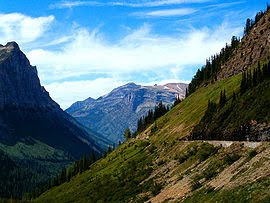
(Glacier National Park Bus)
Of course where there are glaciers there's going to be water and Glacier National Park has tons of it. This park alone has more than 200 waterfalls and 200 lakes. Sixty -nine of these lakes are  even unnamed. Which means that 131of these lakes are named. Due to the erosion and melting of these glaciers the appearance of the lakes can range from milky brown to turquoise to sapphire blue to extremely clear.
even unnamed. Which means that 131of these lakes are named. Due to the erosion and melting of these glaciers the appearance of the lakes can range from milky brown to turquoise to sapphire blue to extremely clear.
Lake McDonald is the largest lake in Glacier National Park. Lake McDonald is 10 miles long and 464 feet deep. That like stacking 58 backyard swimming pools (8ft deep) on top of each other. 
(Lake McDonald)
The mountains these Ice Age glaciers carved out were pretty big. The glaciers also carved U-shaped valleys and small canyons. Though these mountains were tall, only 6 of the peaks go over 10,000 feet. Years of erosion  most likely wore the mountains down to their current size.
most likely wore the mountains down to their current size.
(Avalanch Gorge)
(bear grass)
In Glacier National Park there are a lot of plants, one of which is the bear grass. Bear grass actually isn't grass at all and bears don't really like to eat it. Once bear grass blooms it dies, and then it takes 5-10 years for it to bloom again. That like forever. The life span of bear grass is really different from the Alpine plants. Those things can live to be more than 100 years old.
Speaking of bears, Glacier National Park has the largest Grizzly population in the lower 48 states. By the way "the lower 48 states" inclued all of the states except Hawaii (in the Pacific Ocean) and Alaska(above the main body of states). Glacier National Park also has a lot of Mountain goats and elk.

 (grizzly bear) (rocky mountain goat)
(grizzly bear) (rocky mountain goat)P.S. grizzlies are not as violent as people think we're just invading there natural habitat and they don't know what to make of us.

